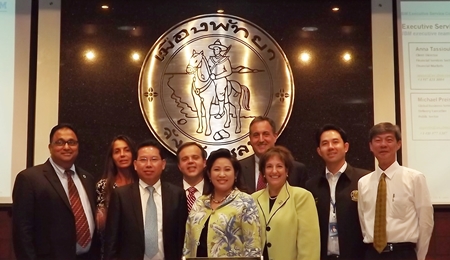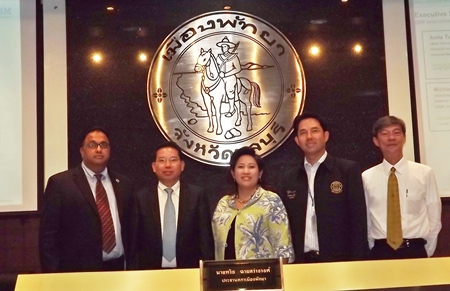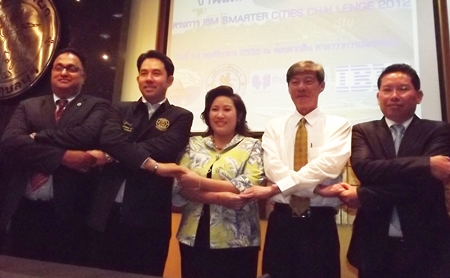International Business Machines Corp. executives wrapped up three weeks in Chonburi, offering both practical and idealistic suggestions on how to create “smarter” cities and ports to officials in Pattaya and Laem Chabang.
The five-person team of consultants made their final “IBM Smarter Cities” presentation to Thai officials Nov. 14 after accumulating and analyzing information, inspecting city and port systems and reviewing the role of information technology in running Pattaya and Laem Chabang Port.
The Smarter Cities Challenge was launched by the IBM Citizenship program in 2010 to offer the time and expertise of the company’s top experts from different business units and geographies for three-week consultations with city leaders to deliver recommendations on how to make cities smarter and more effective.
 IBM executives pose at City Hall after presenting their ideas about building a public security system for tourists, improving traffic in Pattaya and increasing logistics potential at Laem Chabang Port.
IBM executives pose at City Hall after presenting their ideas about building a public security system for tourists, improving traffic in Pattaya and increasing logistics potential at Laem Chabang Port.
Nine of this year’s 33 cities came from Asia, joining 44 others previously selected globally, including Chiang Mai, where IBM focused the city on “Smarter Healthcare” and “Smarter Food.”
Team leader Michael Preis, delivery executive for IBM Global Business Services, said the final report focused on security development, public safety, traffic management and community issues in Pattaya, and logistics management and operations at Laem Chabang.
In Pattaya, the consultants’ most practical suggestions centered around the idea of creating a “security command center” that would use “predictive analytics” to forecast short- and long-term needs and prioritize objectives. Predictive analytics encompasses a variety of statistical techniques from modeling, machine learning, and data mining that analyze current and historical facts to make predictions about future events.
Other recommendations include using traffic and public security information to connect incidents, integrating water-quality, sanitation and other systems, and more cooperation between the public sector and private-sector volunteers.
IBM’s ideas for traffic management improvements appear more philosophical than applicable. Suggestions to improve the land-transport master plan, strengthen the role of traffic engineers, and adding “an analytic system allowing the city to have a much deeper information to use for planning and promotion of law enforcement” are too tied to macro-government policy and cultural traditions in the workplace to be applied immediately.
Likewise, the suggestions to make public safety “smarter” are even more amorphous. The list of recommendations includes “coordinating and urging agencies and organizations to prepare for emergencies,” “enhancing the integration and management of crisis and emergency,” and “increasing law coordination, cooperation and enforcement.”
The public safety section of the report does have a few ideas that can be acted on quickly, such as building an information center “to merge daily practice information and use advance data analysis support” and urging businesses to register employees. Others, however, are vague on the details, such as the suggestion to “use call centers effectively.”
But when it came to suggestions for a “smarter community,” the IBM consultants seemed content to throw out more platitudes than concrete. The final report suggests such ideals as “campaigning for citizens to be open about other cultures” and “increasing understanding and community cooperation to improve the image of the city for tourism.”
In Laem Chabang, IBM worked closer to its comfort zone, offering suggestions on improving worker efficiency, listing port services that could benefit from technology and analyzing the design of traffic-management and cargo-handling systems.
The consultants cited the need for port officials to develop a “blueprint” for architectural modifications at the harbor, implement “electronic dashboards” and mobile technology to increase efficiency, and use analytics to better plan to predict cargo-throughput demand.
But when the IBM academics got into the port’s rocky relationship with its neighbors, the suggestions again leaned more toward platitudes than plans. The consultants suggested the port draft a “Corporate Social Responsibilities” document with the community, and give community leaders more participation in port-expansion plans.






